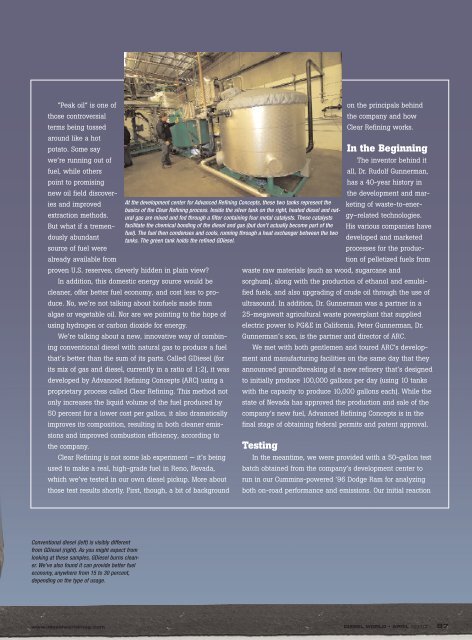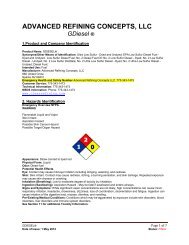The Next Generation Diesel Fuel? - Advanced Refining Concepts
The Next Generation Diesel Fuel? - Advanced Refining Concepts
The Next Generation Diesel Fuel? - Advanced Refining Concepts
Create successful ePaper yourself
Turn your PDF publications into a flip-book with our unique Google optimized e-Paper software.
“Peak oil” is one of<br />
on the principals behind<br />
those controversial<br />
the company and how<br />
terms being tossed<br />
around like a hot<br />
Clear <strong>Refining</strong> works.<br />
potato. Some say<br />
In the Beginning<br />
we’re running out of<br />
<strong>The</strong> inventor behind it<br />
fuel, while others<br />
all, Dr. Rudolf Gunnerman,<br />
point to promising<br />
has a 40-year history in<br />
new oil field discover-<br />
the development and maries<br />
and improved<br />
extraction methods.<br />
At the development center for <strong>Advanced</strong> <strong>Refining</strong> <strong>Concepts</strong>, these two tanks represent the<br />
basics of the Clear <strong>Refining</strong> process. Inside the silver tank on the right, heated diesel and natural<br />
gas are mixed and fed through a filter containing four metal catalysts. <strong>The</strong>se catalysts<br />
keting of waste-to-energy–related<br />
technologies.<br />
But what if a tremen- facilitate the chemical bonding of the diesel and gas (but don’t actually become part of the His various companies have<br />
dously abundant<br />
fuel). <strong>The</strong> fuel then condenses and cools, running through a heat exchanger between the two<br />
tanks. <strong>The</strong> green tank holds the refined G<strong>Diesel</strong>.<br />
developed and marketed<br />
source of fuel were<br />
processes for the produc-<br />
already available from<br />
tion of pelletized fuels from<br />
proven U.S. reserves, cleverly hidden in plain view? waste raw materials (such as wood, sugarcane and<br />
In addition, this domestic energy source would be sorghum), along with the production of ethanol and emulsi-<br />
cleaner, offer better fuel economy, and cost less to profied fuels, and also upgrading of crude oil through the use of<br />
duce. No, we’re not talking about biofuels made from ultrasound. In addition, Dr. Gunnerman was a partner in a<br />
algae or vegetable oil. Nor are we pointing to the hope of 25-megawatt agricultural waste powerplant that supplied<br />
using hydrogen or carbon dioxide for energy.<br />
electric power to PG&E in California. Peter Gunnerman, Dr.<br />
We’re talking about a new, innovative way of combin- Gunnerman’s son, is the partner and director of ARC.<br />
ing conventional diesel with natural gas to produce a fuel We met with both gentlemen and toured ARC’s develop-<br />
that’s better than the sum of its parts. Called G<strong>Diesel</strong> (for ment and manufacturing facilities on the same day that they<br />
its mix of gas and diesel, currently in a ratio of 1:2), it was announced groundbreaking of a new refinery that’s designed<br />
developed by <strong>Advanced</strong> <strong>Refining</strong> <strong>Concepts</strong> (ARC) using a to initially produce 100,000 gallons per day (using 10 tanks<br />
proprietary process called Clear <strong>Refining</strong>. This method not with the capacity to produce 10,000 gallons each). While the<br />
only increases the liquid volume of the fuel produced by state of Nevada has approved the production and sale of the<br />
50 percent for a lower cost per gallon, it also dramatically company’s new fuel, <strong>Advanced</strong> <strong>Refining</strong> <strong>Concepts</strong> is in the<br />
improves its composition, resulting in both cleaner emissions<br />
and improved combustion efficiency, according to<br />
final stage of obtaining federal permits and patent approval.<br />
the company.<br />
Testing<br />
Clear <strong>Refining</strong> is not some lab experiment — it’s being In the meantime, we were provided with a 50-gallon test<br />
used to make a real, high-grade fuel in Reno, Nevada, batch obtained from the company’s development center to<br />
which we’ve tested in our own diesel pickup. More about run in our Cummins-powered ’96 Dodge Ram for analyzing<br />
those test results shortly. First, though, a bit of background both on-road performance and emissions. Our initial reaction<br />
Conventional diesel (left) is visibly different<br />
from G<strong>Diesel</strong> (right). As you might expect from<br />
looking at these samples, G<strong>Diesel</strong> burns cleaner.<br />
We’ve also found it can provide better fuel<br />
economy, anywhere from 15 to 30 percent,<br />
depending on the type of usage.<br />
www.dieselworldmag.com<br />
DIESEL WORLD • APRIL 2010 87



